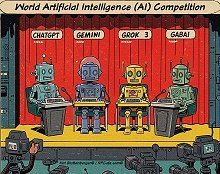Electronics & High Technology Components
- See Full List of AI Topics -
The history of
superconductors
spans over a century and has led to significant advancements in the field of
physics and technology. A superconductor is a material that exhibits zero
electrical resistance and the expulsion of magnetic fields when it is cooled
below a critical temperature. In other words, it can conduct electric current
without any loss of energy due to resistance, and it can also expel magnetic
fields from its interior. This phenomenon is known as superconductivity.
Superconductors have numerous practical applications, including in the
construction of powerful magnets for medical devices like MRI machines,
high-speed electronic circuits, and potentially even in energy transmission and
storage systems. Superconductivity is a quantum mechanical phenomenon that was
first discovered in certain metals and has since been observed in various
materials, including ceramics and some specialized compounds.
Discovery of Superconductivity (1911):
Superconductivity was first discovered by Heike Kamerlingh Onnes, a Dutch physicist,
in 1911. He was conducting experiments to liquefy helium when he observed that the
electrical resistance of mercury dropped to zero at temperatures below 4.2 Kelvin
(-268.95°C or -452.11°F).
Early Discoveries and Research (1911-1930s):
Researchers like John Bardeen, Leon Cooper, and Robert Schrieffer developed the
BCS theory of superconductivity in 1957, which explained the behavior of conventional
(low-temperature) superconductors. This theory is still widely accepted today. During
this time, several superconducting materials were discovered, including lead, niobium,
and tin.
Liquid Helium Era (1950s-1960s):
The early era of superconductivity research mainly focused on low-temperature
superconductors that required liquid helium for cooling. This limited their practical
applications due to the high cost and difficulty of maintaining such low temperatures.
High-Temperature Superconductors (1986):
A major breakthrough came in 1986 when IBM researchers Georg Bednorz and K. Alex
Müller discovered a new class of superconductors that exhibited superconductivity
at significantly higher temperatures. Their discovery involved copper oxides, specifically
La-Ba-Cu-O compounds, which became known as "high-temperature superconductors."
These materials could operate at temperatures above the boiling point of liquid
nitrogen (-196°C or -321°F), making them more practical for various applications.
Further Research and Applications:
High-temperature superconductors sparked intense research, leading to the discovery
of various other families of materials with similar properties. Superconductors
found applications in various fields, including medical imaging (MRI machines),
particle accelerators, power transmission, and more. Researchers continued to work
on increasing the critical temperatures (Tc) of superconductors, as well as developing
practical methods for producing and using them.
Iron-Based Superconductors:
In 2008, a new class of superconductors called "iron-based superconductors" was
discovered. These materials also exhibit superconductivity at relatively high temperatures,
although not as high as some high-temperature cuprate superconductors.
 This content was generated by primarily
with the assistance of ChatGPT (OpenAI), and/or
Gemini (Google), and/or
Arya (GabAI), and/or Grok
(x.AI), and/or DeepSeek artificial intelligence
(AI) engines. Review was performed to help detect and correct any inaccuracies; however,
you are encouraged to verify the information yourself if it will be used for critical
applications. In all cases, multiple solicitations to the AI engine(s) was(were)
used to assimilate final content. Images and external hyperlinks have also been
added occasionally - especially on extensive treatises. Courts have ruled that AI-generated
content is not subject to copyright restrictions, but since I modify them, everything
here is protected by RF Cafe copyright. Many of the images are likewise generated
and modified. Your use of this data implies an agreement to hold totally harmless
Kirt Blattenberger, RF Cafe, and any and all of its assigns. Thank you. Here is
Gab AI in an iFrame. This content was generated by primarily
with the assistance of ChatGPT (OpenAI), and/or
Gemini (Google), and/or
Arya (GabAI), and/or Grok
(x.AI), and/or DeepSeek artificial intelligence
(AI) engines. Review was performed to help detect and correct any inaccuracies; however,
you are encouraged to verify the information yourself if it will be used for critical
applications. In all cases, multiple solicitations to the AI engine(s) was(were)
used to assimilate final content. Images and external hyperlinks have also been
added occasionally - especially on extensive treatises. Courts have ruled that AI-generated
content is not subject to copyright restrictions, but since I modify them, everything
here is protected by RF Cafe copyright. Many of the images are likewise generated
and modified. Your use of this data implies an agreement to hold totally harmless
Kirt Blattenberger, RF Cafe, and any and all of its assigns. Thank you. Here is
Gab AI in an iFrame.
AI Technical Trustability Update
While working on an update to my
RF Cafe Espresso Engineering Workbook project to add a couple calculators about
FM sidebands (available soon). The good news is that AI provided excellent VBA code
to generate a set of Bessel function
plots. The bad news is when I asked for a
table
showing at which modulation indices sidebands 0 (carrier) through 5 vanish,
none of the agents got it right. Some were really bad. The AI agents typically explain
their reason and method correctly, then go on to produces bad results. Even after
pointing out errors, subsequent results are still wrong. I do a lot of AI work
and see this often, even with subscribing to professional versions. I ultimately
generated the table myself. There is going to be a lot of inaccurate information
out there based on unverified AI queries, so beware.
Electronics & High Tech
Companies | Electronics &
Tech Publications | Electronics &
Tech Pioneers | Electronics &
Tech Principles |
Tech Standards Groups &
Industry Associations | Societal
Influences on Technology
|







